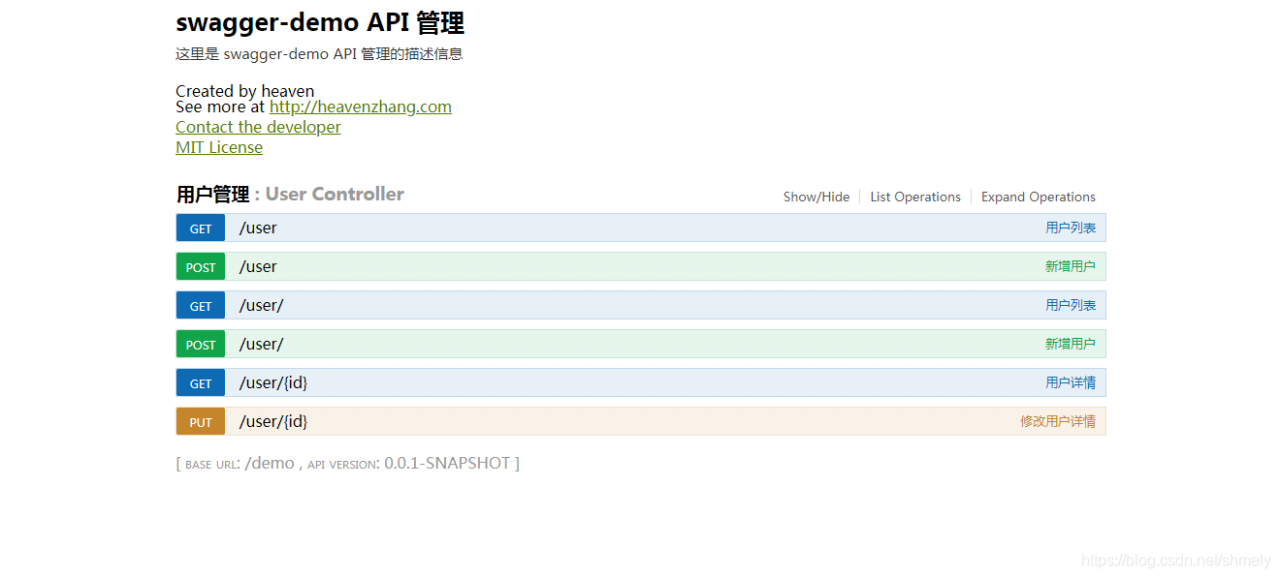相信各位在公司写API文档数量应该不少,当然如果你还处在自己一个人开发前后台的年代,当我没说,如今为了前后台更好的对接,还是为了以后交接方便,都有要求写API文档。常用的工具有诸如小幺鸡、showdoc等,不过都需要人工进行编辑,大大影响了效率,或者是无法在线测试,接口更改后又得重新修改接口文档。
Swagger也就是为了解决这个问题,当然也不能说Swagger就一定是完美的,当然也有缺点,最明显的就是代码移入性比较强。其他的不多说,想要了解Swagger的,可以去Swagger官网,可以直接使用Swagger editor编写接口文档,当然我们这里讲解的是SpringBoot整合Swagger2,直接生成接口文档的方式。
一、pom导包
<dependency>
<groupId>com.spring4all</groupId>
<artifactId>spring-boot-starter-swagger</artifactId>
<version>1.5.1.RELEASE</version>
</dependency>二、swagger配置编写,application.yml
swagger:
# 是否启用swagger,默认:true
enabled: true
# 标题
title: swagger-demo API 管理
# 描述
description: 这里是 swagger-demo API 管理的描述信息
# 版本
version: 0.0.1-SNAPSHOT
# 许可证
license: MIT License
contact:
# 维护人
name: heaven
# 维护人URL
url: http://heavenzhang.com
# 维护人URL
email: 441339905@qq.com
# swagger扫描的基础包,默认:全扫描
base-package: com.heaven
# 需要处理的基础URL规则,默认:/**
base-path: /**
# 需要排除的URL规则,默认:空
exclude-path: /error三、Restfull API接口
package com.heaven.springbootdemoswagger.controller;
import com.google.common.collect.Lists;
import com.xiaoleilu.hutool.util.StrUtil;
import com.heaven.springbootdemoswagger.model.User;
import io.swagger.annotations.Api;
import io.swagger.annotations.ApiOperation;
import io.swagger.annotations.ApiParam;
import org.springframework.web.bind.annotation.*;
import springfox.documentation.annotations.ApiIgnore;
import javax.validation.Valid;
import java.util.List;
@Api(tags = "用户管理")
@RestController
@RequestMapping("/user")
public class UserController {
@ApiOperation("新增用户")
@PostMapping({"", "/"})
public User insert(@RequestBody @Valid User user) {
return user;
}
@ApiIgnore
@DeleteMapping("/{id}")
public String deleteById(@PathVariable Long id) {
return "已删除用户 --> " + id;
}
@ApiOperation("修改用户详情")
@PutMapping("/{id}")
public User update(@PathVariable Long id, @RequestBody @Valid User user) {
user.setId(id);
return user;
}
@ApiOperation("用户详情")
@GetMapping("/{id}")
public User findById(@PathVariable Long id) {
return new User(id, "heaven" + id, 21, StrUtil.format("heaven{}@163.com", id), StrUtil.fill("186", id.toString().charAt(0), 11, false));
}
@ApiOperation("用户列表")
@GetMapping({"", "/"})
public List<User> index(@ApiParam("第几页") @RequestParam(defaultValue = "1") Integer pageNum, @ApiParam("每页的条目数") @RequestParam(defaultValue = "20") Integer pageSize) {
List<User> users = Lists.newArrayList();
users.add(new User(0L, "heaven0", 18, "heaven0@163.com", "18600000000"));
users.add(new User(1L, "heaven1", 19, "heaven1@163.com", "18611111111"));
return users;
}
}
四、启动类加@EnableSwagger2Doc注解
package com.heaven.springbootdemoswagger;
import com.spring4all.swagger.EnableSwagger2Doc;
import org.springframework.boot.SpringApplication;
import org.springframework.boot.autoconfigure.SpringBootApplication;
@SpringBootApplication
@EnableSwagger2Doc // 启用 Swagger
public class SpringBootDemoSwaggerApplication {
public static void main(String[] args) {
SpringApplication.run(SpringBootDemoSwaggerApplication.class, args);
}
}
五、启动SpringBoot项目,访问 http://localhost:8080/swagger-ui.html

具体里面的内容以及接口测试,应该一看就懂了。这里就不一一截图了。
六、Swagger注解
swagger通过注解表明该接口会生成文档,包括接口名、请求方法、参数、返回信息的等等。
@Api:修饰整个类,描述Controller的作用
@ApiOperation:描述一个类的一个方法,或者说一个接口
@ApiParam:单个参数描述
@ApiModel:用对象来接收参数
@ApiProperty:用对象接收参数时,描述对象的一个字段
@ApiResponse:HTTP响应其中1个描述
@ApiResponses:HTTP响应整体描述
@ApiIgnore:使用该注解忽略这个API
@ApiError :发生错误返回的信息
@ApiImplicitParam:一个请求参数
@ApiImplicitParams:多个请求参数